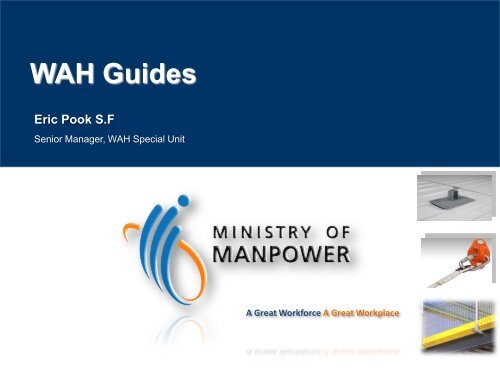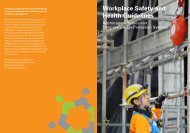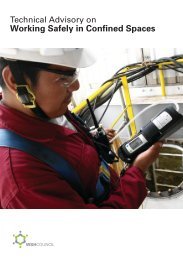WSH Guidelines on WAH Personnel Protective Equipment and ...
WSH Guidelines on WAH Personnel Protective Equipment and ...
WSH Guidelines on WAH Personnel Protective Equipment and ...
Create successful ePaper yourself
Turn your PDF publications into a flip-book with our unique Google optimized e-Paper software.
A Great Workforce A Great Workplace<strong>WAH</strong> GuidesEric Pook S.FSenior Manager, <strong>WAH</strong> Special UnitA Great Workforce A Great Workplace© 2012 Government of Singapore 1
A Great Workforce A Great WorkplaceIntroducti<strong>on</strong>© 2012 Government of Singapore 2
What is “Working at Height”?A Great Workforce A Great Workplace“Work at Height” means –(a) work in any place, including a place at or below ground level; or(b) obtaining access to or egress from such place while at work,where a pers<strong>on</strong> could fall from a height which may cause bodily injury.© 2012 Government of Singapore 3
A Great Workforce A Great WorkplaceImpact Force of Falling ObjectFear the≈ 1959 kgf≈ 3430 kgf≈ 6370 kgf≈ 222 kgfto crack ahuman skull≈ 330 kgfto crack arib≈ 400 kgfto crack afemur© 2012 Government of Singapore 6
A Great Workforce A Great WorkplaceC<strong>on</strong>cept of Working at HeightsRespectRiskAssessmentEliminate orSubstitute <strong>WAH</strong>ActivitiesTemporaryEdge Protecti<strong>on</strong>SystemsAnchorages +Lifelines withPPETravel -RestraintSystemsFall ArrestSystemsLastOpti<strong>on</strong>!© 2012 Government of Singapore 7
A Great Workforce A Great WorkplaceTemporary Edge Protecti<strong>on</strong> System ( 周 边 护 栏 )Temporary edge protecti<strong>on</strong> system is a set ofcomp<strong>on</strong>ents intended to protect the workers from thepossibility of falling to a lower level from any exposededges/ or open sides.© 2012 Government of Singapore 9
A Great Workforce A Great WorkplaceCriteria in Selecting/ Installing of TEPSType & Nature of WorkAccess & Egress MeansMethod of Erecti<strong>on</strong>Dismantling ProceduresRescue Means & Procedures© 2012 Government of Singapore 10
A Great Workforce A Great Workplace‘Deadly’ TEPSRebarRebar© 2012 Government of Singapore 11
A Great Workforce A Great WorkplaceClasses of TEPSClasses of Temporary Edge Protecti<strong>on</strong> Systems (ref. BS EN 13374:2004)Class A system is designed to withst<strong>and</strong> to static loads <strong>on</strong>ly, based <strong>on</strong> the requirements to: Support a worker leaning <strong>on</strong>to the protecti<strong>on</strong> element or provide a h<strong>and</strong>hold when walking besideit, <strong>and</strong> Arrest the fall of a worker who is walking or possibility of falling towards the protecti<strong>on</strong>.Principal Guardrail≥ 1000mm< 600mmVertical PostIntermediate Guardrail< 600mm≥ 90 mmWorking SurfaceDimensi<strong>on</strong> RequirementsToeboardClass A: Static Loading RequirementsFor workingsurfacenot morethan 10º© 2012 Government of Singapore 12
A Great Workforce A Great WorkplaceClasses of TEPSClasses of Temporary Edge Protecti<strong>on</strong> Systems (ref. BS EN 13374:2004)Class B system (comm<strong>on</strong>ly used <strong>on</strong> roof pitches) is designed to withst<strong>and</strong> static loads <strong>and</strong> low dynamicforces <strong>on</strong>ly which is based <strong>on</strong> the following requirements to:Support a worker leaning <strong>on</strong>to the protecti<strong>on</strong> element or provide a h<strong>and</strong>hold when walking beside it,Arrest a worker who is walking or possibility of falling towards the protecti<strong>on</strong>Arrest a falling worker whom slides down a slopeFor working surfaces:• < 30º(no limitati<strong>on</strong> for falling height)• < 60º(falling height < 2m)Class B Loading Requirements© 2012 Government of Singapore 13
A Great Workforce A Great WorkplaceClasses of TEPSClasses of Temporary Edge Protecti<strong>on</strong> Systems (ref. BS EN 13374:2004)Class C system is designed to withst<strong>and</strong> high dynamic forces based <strong>on</strong> the requirements to arrest afalling worker sliding down a steeply slope surface.It shall be able to absorb a kinetic energy of 2.2kJ (anywhere al<strong>on</strong>g the protecti<strong>on</strong> up to 200mmheight above working surface)For working surfaces:• 30º ~ 45º(no limitati<strong>on</strong> for falling height)• 45º ~ 60º(falling height < 5m)© 2012 Government of Singapore 14
A Great Workforce A Great WorkplaceMaterials for TEPSMaterials use for c<strong>on</strong>structi<strong>on</strong> of temporary edge protecti<strong>on</strong> systems shall be sufficiently robust<strong>and</strong> durable to withst<strong>and</strong> normal working c<strong>on</strong>diti<strong>on</strong>s.These materials shall be free from any impurities <strong>and</strong> defects that may affect their satisfactoryuse.prEN 74-1 #2TimberBS EN 338: 2009 Structural timber. Strength classesNote:• If protective coating is being applied <strong>on</strong> timber, itshall not prevent the detecti<strong>on</strong>/ discovery of materialdefects.• If plywood is to be used, it shall have at least 5 piles<strong>and</strong> shall have a minimum 9mm thickness.• It shall have good climate durability c<strong>on</strong>diti<strong>on</strong>.AluminiumEN 12811-2 #1 , prEN 74-1 #2Note:• Rimming steels (deoxidati<strong>on</strong> steel) or “drawingquality steel” shall not be used.SteelReferences:#1 BS EN 12811-2:2004 Temporary works equipment.Informati<strong>on</strong> <strong>on</strong> materials#2 prEN 74-1:2002 Couplers, spigot pins <strong>and</strong> baseplates for use in falsework <strong>and</strong> scaffolds - Part 1:Couplers for tubes - Requirements <strong>and</strong> testprocedures© 2012 Government of Singapore 15
A Great Workforce A Great WorkplaceTemporary Edge Protecti<strong>on</strong> Systems(ref. BS EN 13374:2004)* Adapted for use <strong>on</strong> Roofs (as TEPS)© 2012 Government of Singapore 16
A Great Workforce A Great WorkplaceAnchorage( 固 定 点 )© 2012 Government of Singapore 17
Comm<strong>on</strong> Terms for AnchorageA Great Workforce A Great WorkplaceAnchor(fixture or placeto securelifelines)Anchorage(‘Anchor Point’ ispart of an anchorfor otherequipmentattachment)Anchor Points( 固 定 点 )Anchor Devices(An element, orseries of elements/comp<strong>on</strong>ents of PFAS)© 2012 Government of Singapore 18
A Great Workforce A Great WorkplaceTypes of AnchorsCast- InThrough typeExp<strong>and</strong>ing SocketChemically B<strong>on</strong>ded© 2012 Government of Singapore 19
Are these fall arrest rated Anchors?A Great Workforce A Great Workplace© 2012 Government of Singapore 20
Anchor DevicesA Great Workforce A Great WorkplaceThere are basically 6 types of anchor devices that are specified in SS570:2011Class A1: Vertical, Horiz<strong>on</strong>tal,Inclined surfacesClass A2: Inclined RoofClass B: TransportabletemporaryClass C: Horiz<strong>on</strong>tal flexiblelifelinesClass D: Horiz<strong>on</strong>tal rigid anchorlifelinesClass E: Dead Weights© 2012 Government of Singapore 21
Reliability <strong>and</strong> Strength of AnchorsA Great Workforce A Great Workplace• Anchors shall be reliable <strong>and</strong> have an adequate strength <strong>and</strong> stability to withst<strong>and</strong>the dynamic <strong>and</strong> static forces• Anchor devices should c<strong>on</strong>form to SS570:2011 (ref. BS EN 795).• A safety factor of 2.0 should be used to calculate the required static strength of ananchor device in a pers<strong>on</strong>al fall protecti<strong>on</strong> system.• In order to arrest a fall for a single pers<strong>on</strong> use, an anchor device with a minimumstatic strength of 12kN should be used.Note: 1 kN = 1000 N = 100 kgf12 kN = 12,000 N = 1200 kgf1 kg = 2.2046 lb1200kg = 2645.52 lbE.g. Medium size car(Avg. 1000kg ~ 1400kg)E.g. Hippo(Avg. 1500kg ~ 1800kg)© 2012 Government of Singapore 22
A Great Workforce A Great WorkplaceSharing of AnchorsFor two or more users that are to be c<strong>on</strong>nected to a same anchor, eitherindependently or through same anchor line, it is important to account for thepossibility that they could fall at the same time.1 anchor 1 User 12 kN (with a safety factor 2.0)1 anchor 2 Users 24 kN (with a safety factor 2.0)1 anchor 3 Users 24 kN + 2 kN = 26 kN (with a safety factor 2.0)1 anchor 4 Users 24 kN + 2 kN + 2 kN = 28 kN (with a safety factor 2.0)© 2012 Government of Singapore 23
Correct/ Incorrect Anchor PointsA Great Workforce A Great WorkplaceThe following areas should never be used as anchor points unless the minimum structuralrequirements have being determined to be safe <strong>and</strong> approved by a competent pers<strong>on</strong>:• St<strong>and</strong>ard Guardrails/ Railings• Ladders/ Rungs• Scaffolding• Light fixtures• C<strong>on</strong>duit/ Plumbing/ Ductwork/ Pipe Vents• C-Clamps• Wiring Harnesses• Rebar (except for positi<strong>on</strong>ing during formwork)• Another lanyard• Roof Stacks, Vents or Fans• Any point which does not meet the structuralrequirements.© 2012 Government of Singapore 24
A Great Workforce A Great WorkplaceLifelines( 救 生 索 )© 2012 Government of Singapore 25
Lifelines ( 救 生 索 )Types of Fall Arrest SystemsA Great Workforce A Great WorkplaceLifelines (C<strong>on</strong>forming) St<strong>and</strong>ardsGuided type fall arrester <strong>and</strong> a rigid vertical anchor line SS 528: Part 4: 2006 (adopted from BS EN 353-1)Guided type fall arrester <strong>and</strong> a flexible vertical anchorlinePers<strong>on</strong>al fall-arrest systems: Vertical rails <strong>and</strong> vertical lifelinesincorporating a sliding-type fall arresterSystem based horiz<strong>on</strong>tal flexible anchor line SS 570: 2011 (adopted from BS EN 795:1997)System based horiz<strong>on</strong>tal rigid anchor linePers<strong>on</strong>al protective equipment for protecti<strong>on</strong> against falls froma height – Single point anchor devices <strong>and</strong> flexible horiz<strong>on</strong>tallifeline systemsTextile lifelines (anchor lines) used for fall arrest systems should be as follows:•kernmantel ropes c<strong>on</strong>forming to BS EN 1891:1998, type A;•hawser-laid polyamide (‘Nyl<strong>on</strong>’) ropes c<strong>on</strong>forming to ISO 1140; <strong>and</strong>•hawser-laid polyester (‘PET’) ropes c<strong>on</strong>forming to ISO 1141Polypropylene (‘PP’) ropes shall not be used for lifelines!KernmantelHawser-laid© 2012 Government of Singapore 26
A Great Workforce A Great WorkplaceTextiles Lifelines‣ Textiles lifeline knots should <strong>on</strong>ly tied by the same competent pers<strong>on</strong>who has thorough knowledge of knots <strong>and</strong> knots tying techniques‣ Knots should never be tied in lifelines made from wire ropesStrength of a rope is reduced at a knot <strong>and</strong> examples of strength loss due to variousmethods of tying knots in a 10.5 mm low stretch rope (c<strong>on</strong>forming to BS EN 1891:1998),type A are:Types of tied KnotsStrength Reducti<strong>on</strong>Bowline 26% to 45%Barrel 23% to 33%Double figure-of-eight 23% to 34%Double figure-of-nine 16% to 32%Double figure-of-ten 13% to 27%As a rule of thumb, a 50% reducti<strong>on</strong> in strength due to the knot should be allowed for togive an adequate margin to cover a worst case situati<strong>on</strong>.© 2012 Government of Singapore 27
A Great Workforce A Great WorkplaceLifelines Devices‘Lifelines devices’ is a collective of comp<strong>on</strong>ents which link an user to an lifelines; <strong>and</strong> allows theuser to travel al<strong>on</strong>gside during an upward, downward <strong>and</strong> horiz<strong>on</strong>tal positi<strong>on</strong>.Note: Lifeline (anchor line) devices are designed to lock automatically <strong>on</strong>to the lifeline (anchor line) when aforce or load is applied (with the excepti<strong>on</strong> of traveller).Types of lifelines devices:1. Length adjusters <strong>on</strong> manually adjustablelanyards for restraint systems2. Rope grabs for work positi<strong>on</strong>ing systemsGuided Type Fall Arrestors3. Travellers for horiz<strong>on</strong>tal anchor linesystems (for restraint systems) <strong>and</strong> for fallarrest systems4. Guided type fall arrestors for use withvertical lifelines for fall arrest systems5. Ascender <strong>and</strong> descender devices (forrope access systems)H<strong>and</strong> Ascender (left), Chest Ascender <strong>and</strong> Descender© 2012 Government of Singapore 28
Vertical Lifelines (VLL)/ Vertical RailA Great Workforce A Great WorkplaceTwo types of vertical lifeline (VLL):permanently or temporarily designedA rigid track that is permanently fastened by anumber of brackets at intervals al<strong>on</strong>g its lengthto a fixed ladder/ or structure where a slidingtypefall arrester can be attached.PermanentlyVLLVertical RailTemporaryVLL© 2012 Government of Singapore 29
A Great Workforce A Great WorkplaceSafety CagesB<strong>on</strong>us SlideAre cages safe?History of Cages• stop miners being hitby buckets of coals• Sit <strong>on</strong> the hoop torest“ So-called safety cages <strong>on</strong>fixed ladders are more likelyto break employee’s limbsthan break their fall, warnsDr. Dave Merchant”© 2012 Government of Singapore 30
Flexible Horiz<strong>on</strong>tal Lifelines SystemA Great Workforce A Great WorkplaceIt is generally a flexible lifeline supported by two or more anchors. A horiz<strong>on</strong>tal line isunderstood (in the BS) to be a line which deviates from the horiz<strong>on</strong>tal by not more than 15º.© 2012 Government of Singapore 31
Flexible Horiz<strong>on</strong>tal Lifelines (HLL)A Great Workforce A Great WorkplaceWire Rope Webbing Fibre RopeStatic strength ofat least 2 timesthe maximum arrestload in lineStatic strength ofat least 3 times themaximum arrest loadin lineStatic strength ofat least 3 times themaximum arrest loadin linePolypropylene ropeshall not be used!© 2012 Government of Singapore 32
Self-Retracting Lifelines (SRL)A Great Workforce A Great Workplace• A Self-Retracting Lifeline ( or “Yo-yo”) involves the use of a spring-loaded reel to reel in anyexcess length of lifeline, ensuring a shortest possible length of lifeline between the user <strong>and</strong> thereel.• In the event of a fall, the retractable lifeline is rapidly pulled out <strong>on</strong> the reel a brakingmechanism is engaged to halt the fall of the user.Dangers using SRL in the horiz<strong>on</strong>tal planeSRLBreaking forces for SRL with webbing-based<strong>and</strong> fibre-rope-based lifelines are both 15kN;<strong>and</strong> wire-rope- based lifeline is 12kN© 2012 Government of Singapore 33
A Great Workforce A Great WorkplaceSwitching of LifelinesPractice 100% tie-off: User to switch between lifelines, the sec<strong>on</strong>d lanyard must bec<strong>on</strong>nected to the next lifeline/ anchorage before the c<strong>on</strong>necti<strong>on</strong> to the previous lifeline isdisengaged.Energy absorber with twin-lanyardsSRLs with twin-lanyards© 2012 Government of Singapore 34
A Great Workforce A Great WorkplaceSelecti<strong>on</strong> of Lifelines© 2012 Government of Singapore 35
A Great Workforce A Great WorkplaceFactors Affecting of LifelinesInspecti<strong>on</strong> of LifelinesUltravioletLightTears or cuts (broken/ loose str<strong>and</strong>s)Glazing of surface (heat damage)Varied str<strong>and</strong> size or shapeStorageSpark/ FlameDecreased elasticity (stiffness) orpresence of lumpsDiscolourati<strong>on</strong>Fricti<strong>on</strong>/Abrasi<strong>on</strong>FactorsAffectingC<strong>on</strong>diti<strong>on</strong>sof LifelinesTemperatureLack of proper terminati<strong>on</strong>Unclear/ missing identificati<strong>on</strong> orinspecti<strong>on</strong> labelsC<strong>on</strong>necting hardware is damaged orin poor c<strong>on</strong>diti<strong>on</strong> (e.g., unable tolock)Dyes/MarkingChemicals© 2012 Government of Singapore 36
‘Deadly’ Practices of Using LifelinesA Great Workforce A Great Workplace© 2012 Government of Singapore 37
A Great Workforce A Great WorkplaceImproper Lifelines <strong>on</strong> RoofSource: www.EngineeringToolbox.com© 2012 Government of Singapore 38
Lifeline <strong>on</strong> Roof ? Fall Arrest?A Great Workforce A Great Workplace© 2012 Government of Singapore 39
A Great Workforce A Great WorkplaceAre these Lifelines?Marine ropes are not fall arrest rated Lifelines!© 2012 Government of Singapore 40
A Great Workforce A Great WorkplacePPE( 个 人 防 护 用 具 )© 2012 Government of Singapore 41
A Great Workforce A Great WorkplaceTravel Restraint Systems ( 限 位 腰 带 )Travel Restraint Belt (a.k.a Work Restraint Belt) is aform of body support (which encircles the wearer’swaist) that prevents the wearer from reaching z<strong>on</strong>eswhere is risk of a fall from height exists.Travel Restraint C<strong>on</strong>necti<strong>on</strong>© 2012 Government of Singapore 42
A Great Workforce A Great WorkplaceWork Positi<strong>on</strong>ing System( 工 作 定 位 腰 带 )Work Positi<strong>on</strong>ing Belt is used for body support (whichencircles the wearer’s waist) that works in tensi<strong>on</strong> toprevent a worker from falling.Work Positi<strong>on</strong>ing C<strong>on</strong>necti<strong>on</strong>© 2012 Government of Singapore 43
Pers<strong>on</strong>al Fall Arrest Systems (PFAS)A Great Workforce A Great Workplace PFAS is a collecti<strong>on</strong> <strong>and</strong> arrangement of comp<strong>on</strong>ents that work in c<strong>on</strong>juncti<strong>on</strong> to arrest auser in a fall from a height. PFAS c<strong>on</strong>sists of an anchorage, c<strong>on</strong>necting device <strong>and</strong> full body harness (which mayinclude a lanyard, decelerati<strong>on</strong> device, lifeline or a combinati<strong>on</strong> of these).ADBCDescend© 2012 Government of Singapore 44
A Great Workforce A Great WorkplaceFull-Body Harness (FBH) ( 防 坠 暖 冲 吊 带 )Class A(M<strong>and</strong>atory)Class D Class E Class PFall ArrestC<strong>on</strong>trolled Descent/AscentC<strong>on</strong>fined-spaceAscentWork Positi<strong>on</strong>ingThe minimum static strength requirement of a full-body harness is 15kN.SS528: Part I: 2006 Specificati<strong>on</strong> for Pers<strong>on</strong>al fall-arrest systems. Part 1: Full-body harnesses© 2012 Government of Singapore 45
A Great Workforce A Great WorkplaceDifferent Types of FBHsHeavier Pers<strong>on</strong>nel For Ladies High Visibility Hot WorkEnvir<strong>on</strong>ments>140kg ComfortBright Colour Fire resistant up to 370 ºCElectricalHazardousDirty Envir<strong>on</strong>mentPetrochemicalIndustryOffshoreEnvir<strong>on</strong>mentElectrical Insulati<strong>on</strong>Polyurethane coatingAnti-staticEmbedded life jacket© 2012 Government of Singapore 46
A Great Workforce A Great WorkplaceC<strong>on</strong>nectors ( 钩 )Class B(Basic C<strong>on</strong>nectors)Class M(Multi-use C<strong>on</strong>nectors)Class T(Terminati<strong>on</strong> C<strong>on</strong>nectors)Class A(Anchor C<strong>on</strong>nectors)Class Q(Screwlink C<strong>on</strong>nectors)Captive eyesThe minimum static strength requirement of a c<strong>on</strong>nector is 20kN #1 ;<strong>and</strong> the recommended static strength for screwlink c<strong>on</strong>nector is 25kN #2#1 SS528: Part 5: 2006 Specificati<strong>on</strong> for Pers<strong>on</strong>al fall-arrest systems. Part 5: C<strong>on</strong>nectors with self-closing an d self-locking gates#2 BS EN 362:2004 Pers<strong>on</strong>al protective equipment against falls from a height. C<strong>on</strong>nectors© 2012 Government of Singapore 47
A Great Workforce A Great WorkplaceForced ‘Roll out’‘Roll-out’ is the result of pressure <strong>on</strong> the gate by a c<strong>on</strong>necting device, such as an anchor,harness attachment point (metal), rope or webbing causing an accidental opening of the gate<strong>and</strong> the release of the c<strong>on</strong>necting comp<strong>on</strong>ent from the c<strong>on</strong>nector.© 2012 Government of Singapore 48
A Great Workforce A Great WorkplaceEnergy Absorbers ( 缓 冲 包 )Energy Absorber - limits the arresting forces applied to the pers<strong>on</strong>al fall-arrest system(PFAS), anchor device <strong>and</strong> user by dissipating the kinetic energy generated during a fall.Type 1Type 2The potential free-fall distance can belimited to a maximum of 1.8mThe potential free-fall distance can belimited to a maximum of 4.0mIf a fall takes place, the arresting force is limited to amaximum of 4.0kNIf a fall takes place, the arresting force is limited to amaximum of 6.0kNA fully deployed energy absorber shall be able to withst<strong>and</strong> a force of 22kN (for Type 1) #1<strong>and</strong> 15kN (for Type 2) #1 without rupturing or tearing apart.SS 528: Part 2: 2006 Specificati<strong>on</strong> for Pers<strong>on</strong>al fall-arrest systems. Part 2: Lanyards <strong>and</strong> energy absorbers:© 2012 Government of Singapore 49
A Great Workforce A Great WorkplaceMaximum Arrest ForceUnderst<strong>and</strong>Maximum force that a pers<strong>on</strong> can be safely subjected to during a fall arrest is 6kN.With Energy AbsorberNo Energy Absorber© 2012 Government of Singapore 50
A Great Workforce A Great WorkplaceUnsafe Practices for EA‘By-pass’‘By-pass’‘Re-use’Unserviceable‘Back Clipping’© 2012 Government of Singapore 51
A Great Workforce A Great WorkplaceLanyard ( 安 全 绳 )Lanyard : finished length of flexible material, which is often use in c<strong>on</strong>juncti<strong>on</strong> with an energyabsorber.Adjustable lanyard : incorporates a designed mechanism that allows the shortening <strong>and</strong>lengthening of its length.LanyardAdjustable LanyardDifferent types of LanyardsMaximum Force (kN)Fibre-rope-based lanyard 22Webbing-based lanyards 22Chain-based lanyards 15Wire-rope-based lanyards 15SS 528: Part 2: 2006 Specificati<strong>on</strong> for Pers<strong>on</strong>al fall-arrest systems. Part 2: Lanyards <strong>and</strong> energy absorbers:© 2012 Government of Singapore 52
A Great Workforce A Great WorkplaceSuspensi<strong>on</strong> Trauma‘Suspensi<strong>on</strong> Trauma’ : a worker (in his full body harness) remains suspended at height after a fall.• Suspensi<strong>on</strong> in a harness may cause blood to pool in the veins of the legs which can result in unc<strong>on</strong>sciousness.• If the worker is not rescued promptly, serious injury or death may occur (in less than 10 minutes).• ‘Harness Pathology’, ‘Harness Hang Syndrome’, ‘Suspensi<strong>on</strong> Intolerance’, ‘Orthostatic Incompetence’ or‘Orthostatic Intolerance’.Suspensi<strong>on</strong> Trauma strap© 2012 Government of Singapore 53
A Great Workforce A Great WorkplaceInspecti<strong>on</strong> of PPE (for <strong>WAH</strong>)© 2012 Government of Singapore 54
A Great Workforce A Great WorkplaceInspecti<strong>on</strong> of PPE (for <strong>WAH</strong>)© 2012 Government of Singapore 55
A Great Workforce A Great WorkplaceInspecti<strong>on</strong> of PPE (for <strong>WAH</strong>)© 2012 Government of Singapore 56
A Great Workforce A Great WorkplaceThe End© 2012 Government of Singapore 57
















